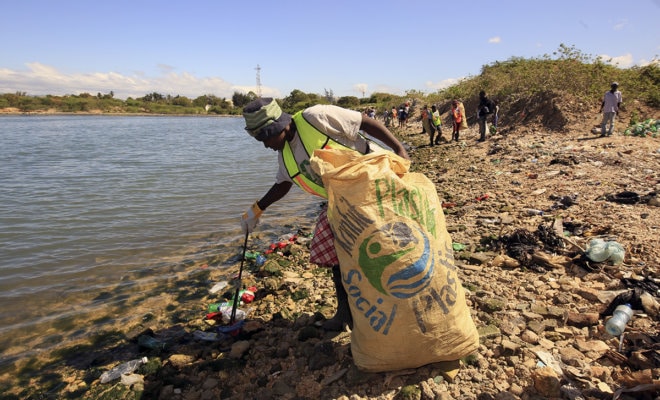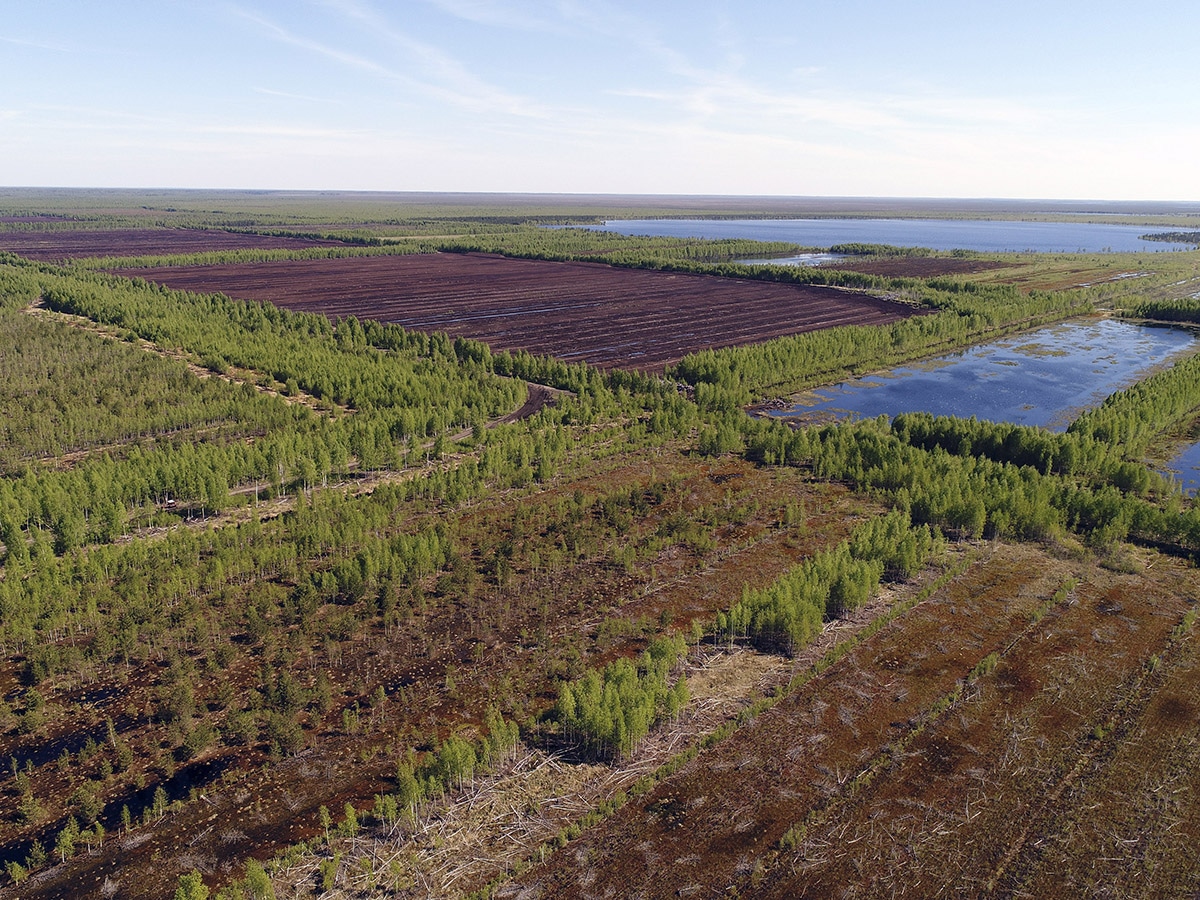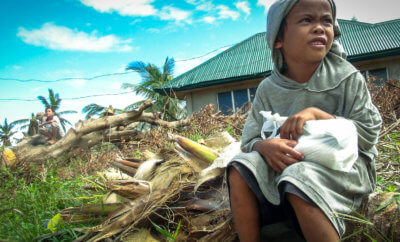Life
On the Attack Against Climate Change

In a photo provided by Plastic Bank, a woman collecting plastic in Haiti, where the Plastic Bank began its work three years ago. Photo: Plastic Bank via The New York Times
Cool-roof demonstration projects in India's Hyderabad and Ahmadabad are among several initiatives that are trying to confront the challenges of climate change around the world.
Thousands of organizations around the world are trying in big ways and small to confront the challenges of climate change. Here are 10 examples.
— Under the Sea
Coral reefs are beautiful to look at, but they also play a crucial role as coastal barriers when storms or flooding hits, absorbing about 97 percent of wave energy.
But because of rising temperatures, coral cover in the Caribbean is estimated to have decreased about 80 percent in the past few decades, said Joseph Pollock, Caribbean coral strategy director at the Nature Conservancy. He added that in 2016, a marine heat wave was estimated to have killed about a third of the shallow corals on Australia’s Great Barrier Reef.
The Nature Conservancy in partnership with Secore International, a conservation organization and a leader in coral restoration, are using an innovative approach to address the problem: helping coral reproduction.
Coral mating works this way, Pollock said: Many coral species spawn by putting out bundles of eggs and sperm one night a year.
“It’s like the craziest singles bar ever,” he said.
Researchers know when those nights are, so they go out, collect the eggs and sperm and then mix them together to cross-fertilize, grow them for a few days or weeks until they become coral juveniles, then place them back in the sea.
The survival rate is about 10 percent, Pollock said, but that’s much better than the survival rate without the help of the scientists. And compared with other restoration techniques, the cross-fertilization creates greater genetic diversity, and that creates more resilience.
The work is focused on the Caribbean now, but Pollock said the hope is that it can be used throughout the world.
“The aim of the work is to develop tools and techniques that are low cost and don’t require a huge amount of super specialized personnel and infrastructure,” he said.

In a photo provided by Resilient Power Puerto Rico, one of the solar microgrids that have been installed by Resilient Power Puerto Rico since Hurricane Maria knocked out most of the island’s power grid in 2017. Photo: Resilient Power Puerto Rico via The New York Times.
— A New Kind of Power
After Hurricane Maria swept through Puerto Rico last year and knocked out almost all its power grid, most residents were left without electricity for months. Jonathan Marvel, one of the founders of Marvel Architects, was born and raised in Puerto Rico. He wanted not only to help bring back power but also do it in a way that would be more environmentally sustainable than it was before the storm.
So, with colleagues and friends, he created Resilient Power Puerto Rico, to develop and install solar microgrids for as many people as he could in the most efficient way possible. The organization, which received an early donation of batteries from Tesla, focused its efforts on areas with high-density, low-rise housing and installed the grids on rooftops of community centers that typically serve 3,000 to 4,000 people.
Their work complements other efforts not only to rebuild the island but also to make its infrastructure more resilient and environmentally green.
One benefit of the solar microgrids is that they can store solar power — allowing them to operate if the main power source is disrupted — which solar panels alone can’t do.
So far, 28 microgrids have been installed, serving close to 100,000 people, Marvel said, and 30 more are almost finished. The cost, covered by donations from companies and individuals, is about $25,000 to $30,000 per solar hub.
Almost all the power on the island is supplied by fossil fuels, but Puerto Rico is “an ideal locale to use solar power and renewable energy because it has so many more solar days than in many parts of the world,” said Marvel, whose offices are based in Manhattan and San Juan. “We want to keep the candle burning with solar energy, not fossil fuel.”

In a photo provided by Kirill Shahmatov, peatland restoration outside Moscow. The abandonment of drained peatlands in parts of Russia has created not only widespread land degradation but also huge quantities of carbon dioxide, which contributes to global warming. Photo: Kirill Shahmatov via The New York Times.
— Saving the Soil
The role that soil plays in climate change is often ignored, but changing the way it is managed could have a big impact on global warming.
Unfortunately, most soil has become less productive, with environmental consequences, said Michael Doane, managing director for agriculture and food systems at the Nature Conservancy. That’s because it has been eroded through too much tilling, lack of adequate ground cover and a failure to diversify crops.
“This living ecosystem has become dead and we’re trying to bring it back to life,” Doane said.
One pilot program, now taking place on more than 100 U.S. farms in about six states, is focused on reducing or eliminating the amount of tillage done on farms. It is done under the auspices of the Soil Health Partnership, a collaboration of environmental groups, farmers, academics and industry working to alter soil health practices.
“Tillage is actually detrimental to soil,” he said. One of the main problems is that tilling releases carbon stored in the soil, which becomes carbon dioxide when exposed to air and contributes to global warming. Tilling also makes the earth more susceptible to erosion and less able to absorb heavy rainfalls.
One solution is using plants — either rotating crops or using ground cover such as grass, depending on what’s needed to repair the soil — to cover the soil before and after the main cash crop is planted. Diverse plant cover has been found to make the soil healthier and helps control weeds, Doane said.
“We want to try to avoid soil bare of plant cover,” he added. “Instead, our vision is a continuous living cover.” Calling it “nature’s solution to climate change,” he said the process of photosynthesis — where plants store the carbon in the soil and release oxygen — could be “a very cost-effective way to mitigate climate change.”
This won’t work on every farm, because each is different, but “we know this works for many farmers in many situations — we have good data on that,” Doane said.
And the process can make farms more productive by creating soil that can better hold water and recycle nutrients, meaning farmers can spend less money on fertilizer.
“If we’re going to solve climate change,” he said, “We have to find economic solutions for people who don’t know they’re solving climate change.”
— Up on the Roof
Keeping cool is becoming more and more difficult as temperatures across the world spike. In addition, air-conditioning uses hydrofluorocarbons, which contribute substantially to global warming.
One solution that numerous cities around the world have embraced is called cool roofs, which is simply painting dark rooftops with a reflective white paint or wrapping them with a light membrane that reduces the absorption of heat. This not only addresses the “urban heat island” effect — urban areas tend to be significantly warmer than surrounding rural areas due to human activities — but also helps decrease strain on electric grids and alleviate air pollution.
A Yale University study cites a finding that if every roof in the United States were painted white, the urban heat island effect would be decreased by one-third.
New York City, for example, has a CoolRoofs Initiative. Since 2009, 5,000 volunteers have painted more than 5 million square feet of rooftops in the city, according to the Mayor’s Office of Sustainability.
In India, where only 10 percent of the households have air-conditioning units, two cities — Hyderabad and Ahmadabad — ran cool-roof demonstration projects. In Ahmadabad, volunteers and others painted 3,000 roofs in slum areas with white lime paint, said Anjali Jaiswal, director of the Natural Resources Defense Council’s India program. The environmental organization worked on the projects with local partners.
DuPont, which has a research center in Hyderabad, owns Tyvek, a synthetic material that is often used in construction and can cover dark roofs. The company donated the material to cover 25 roofs in the city. Both paint and the coverings are considered equally effective, Jaiswal said.
Cool roofs can reduce indoor temperature 3 to 9 degrees Fahrenheit, she added, for as little as 7 cents a square foot or $4 a home.
As incomes and temperatures rise, so is demand for air-conditioning, she said. An important aspect of addressing climate change will be both developing more environmentally friendly units and reducing the demand for them.
Both Indian cities are now developing a citywide cool-roofs policy mandating them for all municipal buildings and working with business leaders’ corporate responsibility programs to expand them throughout the cities.
For relatively little cost, Jaiswal said, cool roofs are “saving lives, reducing temperatures and responding to climate change.”
— Turning Plastic Into Money
Collecting plastic to recycle as a way to earn money is nothing new. But David Katz, founder and chief executive of the Plastic Bank, has created a virtuous cycle of buying and reselling the plastic.
The company’s idea, which last year received a U.N. “Momentum for Change” climate solutions award, aims to stop plastic before it even gets to the ocean by having collectors pick it up around canals, waterways and other areas that lead into the ocean. Through partnerships between the Plastic Bank and major corporations such as the German-based Henkel, the plastic is then reused. That cuts down on the emissions that cause greenhouse gasses used to make new plastic.
According to research from the nonprofit Earth Day Network, about 8 million metric tons of plastic pollution are discarded into the ocean every year, equivalent to one garbage truck full of plastics being dumped every minute.
Plastic Bank, based in Vancouver, British Columbia, started its work in Haiti three years ago; now about 2,000 collectors there can either receive cash, buy goods or services — such as cooking oil, LED lights or topping off pay-as-you-go cellphones — at one of the 40 recycling outlets around the country. They also have the ability, through the Plastic Bank’s app developed in partnership with IBM, to transfer the money into an online savings account.
In Haiti, where more than half the people live on less than $2 a day, a full-time collector can receive several dollars a day, Katz said.
The company also trains and supports local people who run the recycling outlets.
The Plastic Bank has expanded to Brazil, and Indonesia; this month, it opened its first site in the Philippines and in the first week, Katz said, collected around 120,000 bottles.
— Neighbors Helping Neighbors
Constance Okollet had never heard of climate change, but she knew that her village in Uganda had been devastated by a 2007 flood that affected most of the country. She knew the weather was growing increasingly unpredictable, making the farming of the typical crops such as maize, sorghum and millet ever more difficult and sending a population that had been poor but self-sufficient spiraling into destitution.
“We thought God was punishing us,” Okollet said. She suggested to her neighbors that they form a group to help one another and was elected to lead what was soon called the Osukuru United Women Network.
At first, they helped each other in small ways, such as pooling their savings. Then in 2009, Okollet heard on the radio that Oxfam, the global relief organization, was holding a meeting focused on food insecurity in the area, and she decided to go.
Once at the meeting, she said: “They kept talking about climate change and I asked, ‘What are you people talking about? What do you mean by that?’”
She learned. And she and other members of the network (which now includes some men) have since begun awareness education about climate change — its impact and how to adapt — through workshops in churches and wherever people gather.
They have undertaken numerous larger projects as well. The network received a $5,000 grant from the Global Greengrants Fund, a nonprofit that provides small grants to local groups working on environmental issues. The money went to buy six teams of oxen, which are much faster than the traditional hand tilling. An acre can be tilled in two days, compared with a hoe, which can take four weeks, Okollet said. This makes it easier to time the planting to good weather.

In a photo provided by Liz Hale, an Ethiopian baby delivered with help from WeCareSolar, a nonprofit whose Solar Suitcases have been received by 3,500 facilities in 27 developing countries. Photo: Liz Hale via The New York Times.
Two years ago, 60 members of the network were also flown to Nairobi, Kenya, to learn how to make and sell charcoal briquettes; deforestation means firewood is scarce and the briquettes in any case are greener. They mix ash, dry leaves and water, which when dried, actually even cook better than wood, she said.
“We also sell the briquettes to make money — even $1 can help,” she said. “You can pay your school fees or start a small business, and you don’t have to take a loan from the bank.”
— Restoring Peatlands
Peatlands may not be the first thing people think about when focusing on climate change, but the abandonment of drained peatlands in parts of Russia has created not only widespread land degradation, but also huge quantities of carbon dioxide, through peat oxidation. And carbon dioxide contributes to global warming.
Over the decades, millions of acres have been drained and used for agriculture, forestry and the extraction of peat, a fuel used for heating and electrical energy. But when it was no longer profitable to dig out the peat, many of the areas were deserted, said Jozef Bednar, project manager for Wetlands International.
“Peatland ecosystems play a crucial role in global climate,” said Bednar, noting that they store several times more carbon dioxide, the leading greenhouse gas than any other ecosystem. As such, he added, “the world’s peat bogs represent an important ‘carbon sink’ — a place where carbon dioxide is stored below ground and can’t escape into the atmosphere and exacerbate global warming.”
Bednar offered one staggering number: Peatlands cover only 3 percent of the global total land area, but emit twice as much carbon dioxide as the world’s forests, which cover more than 30 percent. The peatlands drained by people are prone to fires and the accompanying smoke spreads long distances, creating serious health problems.
Wetlands International, along with its partners under the International Climate Initiative of the German government, began a major restoration of the peatlands after the extensive peat fires in the Moscow region in 2010. The goal is to return the peatlands to their original waterlogged state. With the help of experts, this is done by correctly blocking drainage ditches and channels so the peatlands’ water-storage capacity is re-established, Bednar said.
The project was awarded a U.N. “Momentum for Change” climate solutions award last year and, to date, about 100,000 acres of drained peatlands have been restored in Russia and the process can be replicated in other countries facing the same problem, he added.
— Climate Literacy
Climate and climate change are complicated, and while schools are a good place to learn about it, not all teachers have the knowledge and resources to teach the topic. That’s why the U.S. National Oceanic and Atmospheric Administration and a partnership of federal agencies, education-focused nongovernmental organizations, teachers and scientists wrote “The Essential Principles of Climate Literacy,” a curriculum guide for teachers.
Available since 2009, but in the process of being updated for release at the end of the year, it is for at all ages and all forms of education, said Frank Niepold, a senior climate education program manager for NOAA and lead author of the guide.
“In the 1990s, less than 1 percent of the national standards for science education was related to climate change. Now about 30 percent is,” he added.
At the same time, the partnership established a website, Cleanet.org, that offers climate and energy educational resources — including quizzes- and guidance for teachers.
Niepold estimated that over 50 percent of children in kindergarten through 12th grade nationwide are learning from all or some of the climate literacy framework, and “we’re on our way to 75 percent,” he said.
Other countries are also using the guide in creating their own curriculums and standards, he added, and this month the National Science Teachers Association released its position paper on teaching climate science, referencing the Essentials of Climate Literacy as one of its sources.
“Students are aware of climate change and want to know more and want to be part of solving it,” Niepold said. “And they know that requires an understanding of the fundamentals.”
— Fighting Energy Poverty
When Laura Stachel, an obstetrician, took a two-week trip to a remote hospital in Nigeria 10 years ago, she was interested in maternal health, not solar energy. But what she saw there changed her mind and her life.
She knew maternal mortality was high: Worldwide, Stachel said, about 300,000 women and 2 million newborns die every year from pregnancy and childbirth complications. But she did not realize the extent of what has been called energy poverty.
The hospital in northern Nigeria that she visited did not have electricity for 12 hours a day. Daytime cesarean sections were done by ambient light, and once, when it occurred in the middle of the night and the power went out, one was performed by the light of Stachel’s headlamp.
She told the stories to her husband, Hal Aronson, who holds a doctorate in environmental sociology and has focused on solar energy issues for years. He designed and built what is now called a Solar Suitcase: solar equipment that is easy to transport, install and use in areas where power supplies are unreliable.
The kit, the size of a suitcase, comes with everything needed from solar panels to medical lighting to fetal monitors. As news about the Solar Suitcases was spreading, Stachel and Aronson also started the nonprofit WeCareSolar, which has received grants from foundations, corporations and individuals. Last year, it received a U.N. “Momentum for Change” climate solutions award.
Working in partnership with nonprofits and U.N. agencies, about 3,500 facilities in 27 developing countries around the world have received the Solar Suitcases. It costs $3,000 to support a clinic with a Solar Suitcase for five years, Stachel said, including all the equipment, transportation and training.
The organization also works to train local people to install and maintain solar power.
The health impact is clear, but so is the impact on the environment, she said. Diesel fuel generators and kerosene lamps are polluting and generate carbon dioxide. But perhaps even more important, the move toward solar would reduce the reliance on fossil fuel — something that some major U.S. hospitals are now trying to do.
“We could leapfrog right past that and go right to clean, green electricity,” she said.
— Greener Refrigeration
Supermarkets around the world are major users of hydrofluorocarbon refrigerants, which contribute to ozone depletion and global warming — and in Chile, they are the biggest user. So, it is fitting that a supermarket chain called Jumbo has become the first in the country to adopt new refrigeration technology that is far more climate friendly than traditional methods.
The new refrigeration technology uses transcritical CO2, which is a refrigerant that has a much smaller effect on the ozone layer and global warming. Hydrofluorocarbon refrigerants had replaced ozone-depleting chlorofluorocarbons, but because their effects on global warming are so severe, there has been a worldwide effort to find a replacement. Hydrofluorocarbons have 1,000 times the heat-trapping potency of carbon dioxide.
Under the Montreal Protocol’s Kigali Amendment, countries must meet specific targets and timelines to replace hydrofluorocarbon refrigerants with more environmentally friendly alternatives.
Jumbo has installed the systems in three supermarkets in Chile and will convert four more stores in the near future, said Claudia Paratori Cortés, coordinator of the Ozone Unit in the Office of Climate Change in Chile’s Ministry of Environment.
Cortés said comparisons between two types of refrigeration — transcritical C02 and one containing hydrofluorocarbons — found that the transcritical C02 systems were 20 to 40 percent more energy efficient, saving around $20,000 annually.
In addition, she said, the residual heat from the transcritical CO2 systems can be used to heat water and therefore save energy.
c.2018 New York Times News Service



